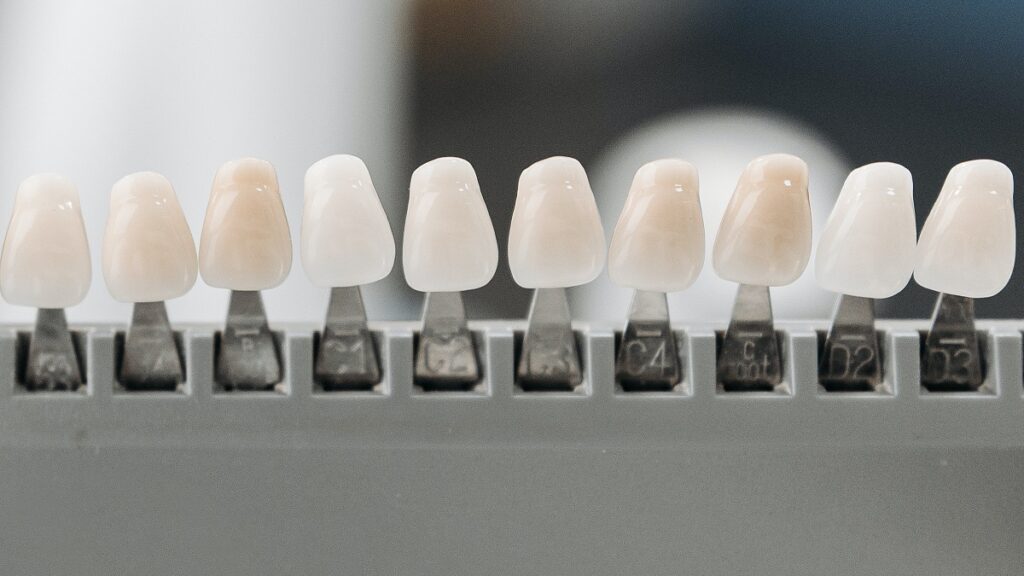If you have porcelain veneers, you may wonder if they can be whitened. Even the most pristine dental work needs care eventually, and it’s perfectly normal to see some discoloration on your veneers after you’ve had them for a while. The short answer is yes, porcelain veneers can be whitened – but only by a professional cleaning or replacement. For a more detailed explanation, read on.
What Causes Stains On Porcelain Veneers?
Stains on porcelain veneers are caused by these factors:
- The dental cement that bonds the veneer and the tooth becomes discolored over time. The glossy, durable finish of porcelain veneers is resistant to staining. However, this dental cement is more porous, and therefore more susceptible to discoloration. This discoloration can be reflected through the translucent veneer. This can give the impression that the veneer is stained.
- Staining foods. Staining food and drinks like coffee and wine can cause discoloration on both natural teeth and veneers.
- Tobacco use. Tobacco use is associated with staining teeth, and it can have a harmful effect on veneers as well.
- Micro-abrasions. Small scratches, or microabrasions, on the veneer surface allows bacteria and food particles to stick to the veneer. As these microparticles accumulate, stains get more noticeable.
- Old veneers. Like all other dental work, veneers degrade over time. It’s not unusual to need a replacement every 6-7 years.
How Do You Prevent Stains On Porcelain Veneers?
Preventing stains on porcelain veneers can be easier than cleaning them. Avoiding staining foods and tobaccos is a good first step. If you still want to indulge, make sure that you brush your teeth shortly after consuming any staining food or drink. This will prevent particles and bacteria from accumulating on your veneers, keeping them whiter for longer.
There are also types of toothpaste that are specially formulated with polishing compounds. These compounds can work well on dental work like veneers, and help prevent staining. Ask your dentist for recommendations on brands of toothpaste that can have a polishing effect on your veneers.
When you brush your veneers, be sure to use a soft-bristle brush, and avoid toothpaste that contains baking soda. Hard-bristle brushes are more likely to damage veneer surfaces. Baking soda wears down veneer finishes and can create microabrasions that give bacteria a place to live. Using baking soda toothpastes can often make veneer staining worse!
How To Whiten Porcelain Veneers
At-home whitening kits don’t work well on veneers. Porcelain veneers are non-porous. This means that they’re less prone to staining than natural teeth, but it also means that the compounds in over-the-counter teeth whitening kits can’t penetrate the veneer surface. At-home kits won’t whiten your veneers, so you’ll need to go to your dentist if you want a veneer whitening treatment that will be effective. A professional-level cleaning can refinish the porcelain glaze on your veneers and make them look new.
However, sometimes veneer staining is just too severe for a cleaning to resolve. In that case, you’ll need to have your veneers replaced by your dentist. It’s not unusual to need a veneer replacement after a few years. You can extend the lifetime of your veneers through proper care, such as the preventative measures mentioned above. Your dentist can tell you if it’s time for you to replace your old porcelain veneers.
Conclusion
Porcelain veneers don’t stain as easily as natural teeth, but they can stain. Preventative measures that prevent staining are the most effective at keeping your veneers white. However, it’s perfectly normal to see some veneer discoloration over time. If you notice a change in the color of your veneers, book an appointment with our office and we’ll come up with a treatment plan to get your porcelain veneers looking better than ever.

